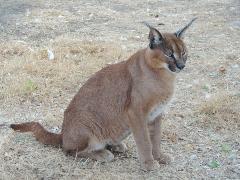Project 3: Canis-Caracal Programme (CCP)
Human population growth and related human activities inevitably increase the level of human-wildlife-livestock conflict on the African continent. An inevitable consequence of such conflicts (some may be fatal to human beings) remains an important cause for the demise of the iconic African lion. Other larger African predators are also affected in this way.
It may seem impossible for people and some dangerous wildlife to coexist, but efforts should be stepped up to find long-term solutions that can mutually benefit both the rural people and wildlife.

Caracal - Photograph taken by Beanelri Janecke
The black-backed jackal (Canis mesomelas) and the caracal (Caracal caracal) are two important medium-sized predator species among South African wildlife, but they also have a huge negative impact on the South African livestock, specifically sheep and goats (Van Niekerk, 2010). Recent studies reported that South African cattle farmers (Badenhorst, 2014) and wildlife ranchers (Schepers, 2016) are also experiencing animal losses because of predation.
.tmb-medium.jpg?sfvrsn=f2b36320_1)
Black-backed jackal - Photograph taken by Beanelri Janecke
A myriad of methods have been used over the past centuries to deter (non-lethal) or kill (lethal) the larger African predators. Despite ongoing efforts over the past decades to reduce the annual losses and huge financial impact to the livestock sector caused specifically by the black-backed jackal and the caracal, little progress has been made. To the contrary, despite large numbers of these two predators being killed annually, reports suggest that predation is on the increase.
There used to be a paucity of available data to substantiate the annual losses incurred by livestock farmers (Van Niekerk, 2010; Badenhorst, 2014) and wildlife ranchers (Schepers, 2016). The combined losses of sheep, goats, cattle, and wildlife may currently exceed ZAR 2 billion annually. Losses are mostly attributed to black-backed jackal and caracal, as well as vagrant dogs (Canis familiaris) near human settlements. The leopard (Panthera pardus) and brown hyaena (Parahyaena brunnea) also cause losses but much less and in isolated cases.
These direct and indirect losses to individuals and the South African economy cannot be allowed to continue unabated. With a view to manage specifically two predator species, namely the black-backed jackal and caracal, and reduce the financial impact on the livestock and wildlife ranching industries, ALPRU launched a comprehensive initiative, the Canis-Caracal Programme (CCP) in December 2004.
The Canis-Caracal Programme is conducted in three phases, comprising several independent but related facets that will run concurrently, namely:
Phase 1: collect and interpret all available data and information and after scientific evaluation, relevant and appropriate information on the black-backed jackal and the caracal will be disseminated to stakeholders and role players.
Phase 2: initiate, support, and conduct scientific studies on the ecology of these two predator species and their natural food base.
Phase 3: assist, in partnership with farmers and conservation authorities, to formulate new or update existing scientific management strategies and policies to regulate these two predator species at national and provincial levels.
As an integral part of the CCP initiative, the human or social component will be closely studied and monitored. For example, it is important to understand the attitudes of farmers and know if it can be changed to assist in making tangible progress to reduce the impact of predation.
Despite focusing over centuries on the large African predator species, and specifically during the past few decades on the black-backed jackal and the caracal, much is still to be learnt. For example, do we really know what role these two predator species play in the ecology, especially with regard to their food habits and natural prey base? How much damage do these two predator species cause to livestock and wildlife? How successful are non-lethal and lethal efforts to manage and reduce their impact? With regard to all the questions, but especially the latter two, very little data exist for most scenarios in South Africa. The available information is fragmented and poorly documented; often it is only vested in a few individuals and seldom shared.
It must be noted that ALPRU/CCP does not advocate a 'wipe out' strategy of these two predators species (such a strategy has not succeeded in the past, or for that matter any predator species), but endeavours to develop practical management strategies to reduce the impact on the livestock farming and wildlife ranching community in South Africa as a matter of high priority. The aim should be to remove those predating individuals who repeatedly cause damage to livestock or wildlife.
If you can assist ALPRU/CCP in reaching its goal to reduce the impact of predation, please contact us for more information on this topic.